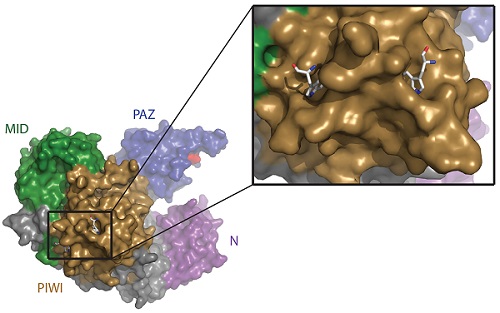Ribonucleases (RNases) are a class of enzymes that degrade ribonucleic acids (RNA) by catalyzing hydrolysis of the phosphodiester backbone. RNases are vital to many cellular processes ranging from messenger RNA (mRNA) decay to DNA replication. Most of these enzymes are relatively non-specific, catalyzing the degradation of RNA with very little sequence specificity. Argonaute proteins, however, are a unique class of RNases that are able to degrade substrate RNAs in a sequence-specific manner. Argonaute proteins are central to a natural gene-silencing process called RNA silencing or RNA interference (RNAi). Argonaute acquires substrate specificity by binding to a small RNA (21 nucleotide), termed the guide RNA, and uses the encoded sequence to locate target mRNAs through base-pairing complementarity. In this way, Argonaute is a highly specific and fully programmable RNase. Once a target RNA is found, Argonaute can either catalyze hydrolysis of the targeted mRNA phosphodiester backbone, or recruit additional silencing factors that inhibit translation and accelerate the decay of the mRNA target. Therefore, the versatility and power of RNAi arises from the fact that Argonaute can be loaded with a small RNA of any sequence and effectively programmed to target and silence any nucleic acid sequence.
Using selenomethionine-incorporated protein crystals for macromolecular crystallography data collection at Beam Line 11-1, scientists from The Scripps Research Institute were able to solve the three-dimensional structure of human Argonaute2 (Fig 1A). The structure immediately revealed how Argonaute is able to selectively identify target RNAs: The guide RNA is cradled in a hydrophilic channel centered between two protein lobes, in which nucleotides 2-7 of the guide, referred to as the “seed” region, are held in a helical confirmation (Fig 1 B). Argonaute makes direct hydrogen-bond contacts only to the phosphate backbone, leaving the base edges solvent exposed and amenable to specific base-pairing interactions. Pre-organization of the nucleotides within the seed region reduces the entropy of binding to target RNAs, thereby allowing Argonaute to locate and bind target RNAs ten times faster than complementary RNAs of similar length (1, 2). Bound targets are threaded through the central channel placing them in proximity to Argonaute’s RNaseH-like domain for cleavage.

In addition to acting as an RNase, Argonaute mediates the recruitment of silencing factors to targeted mRNAs. The main binding partner of Argonaute is a glycine- and tryptophan-rich protein called TNRC6, where the many tryptophan residues in the N-terminal region have been shown to be important in mediating the interaction with Argonaute (3). X-ray crystallography data were again collected at Beam Line 11-1 to solve the crystal structure of human Argonaute2 bound to L-tryptophan. Two tryptophan molecules were found with their indole sidechains buried within hydrophobic pockets and their main chain atoms solvent exposed (Fig 2). Given that a short distance separated the tryptophan molecules, a mechanism was proposed by which two tryptophans could be bound in tandem. Indeed, two tryptophans separated by a short amino acid sequence is a motif repeated throughout the primary sequence of TNRC6, suggesting a novel Argonaute-binding mode.

RNAi has widespread use as a scientific tool, enabling knockdown of specific target genes and allowing reverse-genetic experiments. The development of RNAi-based therapeutics promises to provide a new type of treatment for human disease, which would be particularly powerful with targets that are “non-druggable” by conventional small-molecule approaches. Future work aims to understand the molecular basis of the Argonaute2 interaction with target RNAs, which will further enable the rational design of novel RNAi therapeutics.
- S. L. Ameres, J. Martinez, and R. Schroeder, "Molecular Basis for Target RNA Recognition and Cleavage by Human RISC", Cell 130, 101 (2007)
- B. Haley, and P. D. Zamore, "Kinetic Analysis of the RNAi Enzyme Complex", Nat. Struct. Mol. Biol. 11, 599 (2004)
- E. Huntzinger, and E. Izaurralde, "Gene Silencing by MicroRNAs: Contributions of Translational Repression and mRNA Decay", Nat. Rev. Genet. 12, 99 (2011)
N. T. Schirle and I. J. MacRae, "The Crystal Structure of Human Argonaute2", Science 336, 1037 (2012); doi: 10.1126/science.1221551.




